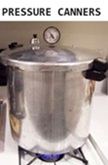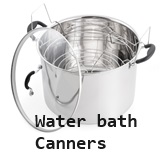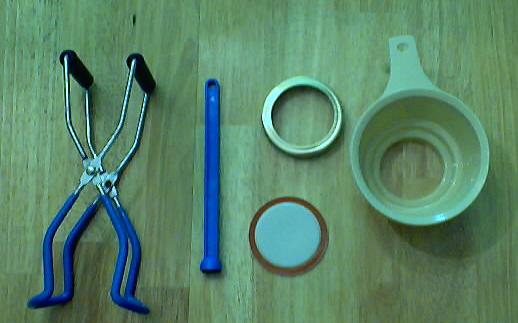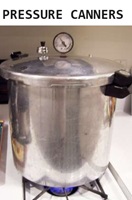
Home Food Storage: Shelf Life of Many Common Fresh, Canned and Frozen Fruits, Vegetables and Other Food Items
How Long Will Fruits and Vegetables Keep:
On the shelf, in the fridge, canned or frozen?
Click here for a PDF print version
With the cost of food as high as it is, and to preserve the taste and nutritional benefit of vegetables and fruits, it is important to know how long food will keep its taste, texture and nutritional value using the available storage methods at home: the refrigerator, freezer, on the counter or canned. The table below lists the estimated storage life, for best quality, for various fruits, vegetables and products from these for each of the home storage methods. Canned and frozen fruit, vegetables and products may be safe beyond these dates if their packaging is intact and the temperatures were maintained; but they are likely to show degradation in text, appearance and texture.
This chart assumes that you started with ripe, but not over fruit fruit and vegetables that were not bruised, moldy, cut open or otherwise damaged. See the explanation at the bottom of the page, following the chart for more details of assumed storage conditions.
Finally, this chart is a work in progress; it is constantly being tweaked and refined, as new varieties of fruit and vegetables enter the marketplace, bring enhanced storage properties. The chart is a combination of research and my own 50 years of experience with home preserving... and there are a LOT of fruits, vegetables and forms of storage here!
Related pages
- Curing Vegetables to Improve Shelf-life - Several vegetables benefit from post-harvest curing.
- Specific Guidance for Handling Certain Vegetables and Fruits - see this page for detailed information about storing apples, garlic, onions, peppers, potatoes, pumpkins, tomatoes and winter squash,
- Where to store fruits and vegetables
- Storage temperatures to avoid - some fruits and vegetables can be damaged by temps that are too high or too low
| Fruit, vegetable or product | Form | Best storage method(s) | Optimal storage temperature (and other conditions, if applicable | Optimal humidity | Typical Useful Storage Life with Various Storage Methods | Best case, at optimal storage temperature and humidity | Comments | |||||
|
F |
C |
At room temperature on the counter |
Basement, or other cool, dark storage area (40 - 65 F) |
Refrigerated (35 - 40 F) |
Frozen (0 F) |
Canned (commercial or properly home canned) |
||||||
| Apples | fresh | Fridge, fruit drawer | 30-40 | -1-4 | 90-95 | 1 week | 3 weeks to 3 months | 3 weeks to 3 months | 1 year | 1 year | 1-12 months | Chill sensitive stored at 35-40 F (2-4 C) It really depends on the variety. Hard, drietr apples, like Fuji's can store for months. SOft, sweet, moist apples, like Gals sppoin within weeks. |
| Applesauce | canned | fridge or cool basement | 40 - 60 | not applicable | 2 weeks | 18 months | 2 years |
|
||||
| Apple butter | canned | not applicable | 6 weeks | 2 years | 5 years | |||||||
| Apple jelly | canned | not applicable | 6 weeks | not suitable | 1 year | |||||||
| Apricots | fresh | 31-32 | -1-0 | 90-95 | 1-3 weeks | |||||||
| Apricot jam | canned | |||||||||||
| Apricots | fresh | 31-32 | -1-0 | 90-95 | 1-3 weeks | |||||||
| Artichokes | fresh | 32-35 | 0-2 | 90-95 | 2-5 months | 2-5 months |
||||||
| Artichokes, Jerusalem | fresh | 31-32 | 0-2 | 90-95 | 2-3 weeks | 4-5 months | ||||||
| Asparagus | fresh | 32-35 | 95-100 | 2-3 weeks | Stand cut end in a glass of water in the fridge to keep it fresher |
|||||||
| Avocados, ripe | fresh | 38-45 | 3-7 | 85-95 | ||||||||
| Avocados, unripe | fresh | 45-50 | 7-10 | 85-95 | Keep away from ethylene producing fruits | |||||||
| Bananas, green | fresh | 62-70 | 17-21 | 85-95 | ||||||||
| Bananas, ripe | fresh | 56-60 | 13-16 | 85-95 | ||||||||
| Basil | fresh | 52-59 | 11-15 | 90-95 | ||||||||
| Beans, dry | fresh | 40-50 | 40-50 | 6-10 months | ||||||||
| Beans, green or snap | fresh | 40-45 | 95 | 7-10 days | ||||||||
| Beans, sprouts | fresh | 32 | 0 | 95-100 | 7-9 days | |||||||
| Beans. Lima | fresh | 37-41 | 0 | 95 | 5-7 days | |||||||
| Beets | fresh | 32-35 | 0-2 | 90-95 | ||||||||
| Beets, bunched | fresh | 32 | 0 | 98-100 | 10-14 days | |||||||
| Beets, topped | fresh | 32 | 0 | 98-100 | 4-6 months | |||||||
| Blackberries | fresh | 32-33 | 0-1 | 90-95 | 2-3 days | |||||||
| Blueberries | fresh | 32-35 | 0-2 | 90-95 | do not wash before storing in fridge, rinse just before using | |||||||
| Bok Choy | fresh | 32-35 | 0-2 | 90-95 | ||||||||
| Broccoli | fresh | 32 | 0 | 95-100 | 10-14 days | |||||||
| Brussels Sprouts | fresh | 32 | 0 | 90-95 | 3-5 weeks | |||||||
| Bunched Greens | fresh | 32 | 0 | 90-95 | Beets, Chard, Green Onions, Mustard, Parsley, Radish, Spinach, Turnip | |||||||
| Cabbage, Chinese | fresh | 32 | 0 | 95-100 | 2-3 months | |||||||
| Cabbage, early | fresh | 32 | 0 | 98-100 | 3-6 weeks | |||||||
| Cabbage, late | fresh | 32 | 0 | 98-100 | 5-6 months | |||||||
| Cantaloupe | fresh | 36-38 | 2-3 | 90-95 | ||||||||
| Carrots, bunched | fresh | 32 | 0 | 95-100 | 4-6 weeks | 4-6 weeks | 4-6 weeks | Ethylene may cause a bitter flavor,trim the tops to 1/2 inch. | ||||
| Carrots, immature | fresh | 32 | 0 | 98-100 | 4-6 weeks | 4-6 weeks | 4-6 weeks | Ethylene may cause a bitter flavor,trim the tops to 1/2 inch. | ||||
| Carrots, mature | fresh | 32 | 0 | 98-100 | 4-8 weeks | 7-9 months | 7-9 months | Ethylene may cause a bitter flavor,trim the tops to 1/2 inch. | ||||
| Cauliflower | fresh | 32 | 0 | 95-98 | 3-4 weeks | |||||||
| Cauliflower | fresh | 32-35 | 0-2 | 90-95 | ||||||||
| Celery | fresh | 32 | 0 | 98-100 | 2-3 months | |||||||
| Celeriac | fresh | 32 | 0 | 97-99 | 6-8 months | |||||||
| Chard | fresh | 32 | 0 | 95-100 | 10-14 days | |||||||
| Cherries | fresh | 32-35 | 0-2 | 90-95 | ||||||||
| Cherries, sour | fresh | 32 | 0 | 90-95 | 3-7 days | do not wash before storing in fridge (unless freezing), rinse just before using | ||||||
| Cherries, sweet | fresh | 30-31 | 90-95 | 2-3 weeks | do not wash before storing in fridge (unless freezing), rinse just before using | |||||||
| Chicory | fresh | 32-35 | 0-2 | 90-95 | ||||||||
| Chicory, witloof | fresh | 32 | 0 | 95-100 | 2-4 weeks | |||||||
| Chinese Pea Pods | fresh | 32-35 | 0-2 | 90-95 | ||||||||
| Coconuts | fresh | 55-60 | 13-16 | 80-85 | Extended storage 32-35 F (0-2 C) | |||||||
| Collards | fresh | 32 | 0 | 95-100 | 10-14 days | |||||||
| Corn, sweet | fresh | 32 | 0 | 95-98 | 5-8 days | |||||||
| Cranberries | fresh | 38-42 | 3-6 | 90-95 | ||||||||
| Cucumbers | fresh | 50-55 | 95 | 10-14 days | ||||||||
| Currants | fresh | 31-32 | 90-95 | 1-4 weeks | ||||||||
| Eggplant | fresh | 46-54 | 90-95 | 1 week | ||||||||
| Elderberries | fresh | 31-32 | 90-95 | 1-2 weeks | ||||||||
| Endive | fresh | 32 | 0 | 95-100 | 2-3 weeks | |||||||
| Escarole | fresh | 32-35 | 0-2 | 90-95 | ||||||||
| Escarole | fresh | 32 | 0 | 95-100 | 2-3 weeks | |||||||
| Figs | fresh | 32-35 | 0-2 | 90-95 | ||||||||
| Garlic | fresh | 32 | 0 | 65-70 | 6-7 months | May be stored at 55-70 F (13-21 C) for shorter periods | ||||||
| Garlic, dry | 32 | 65-70 | 65-70 | do not remove skins |
6-7 months |
|||||||
| Ginger Root | fresh | 60-65 | 16-18 | 65-70 | ||||||||
| Gooseberries | fresh | 31-32 | 90-95 | 3-4 weeks | ||||||||
| Grapefruit | fresh | 55-60 | 13-16 | 90-95 | ||||||||
| Grapes | fresh | 31-32 | 85 | 2-8 weeks | ||||||||
| Green Beans | fresh | 40-45 | 4-7 | 90-95 | ||||||||
| Green Peas | fresh | 32-35 | 0-2 | 90-95 | ||||||||
| Greens, leafy | fresh | 32 | 0 | 95-100 | 10-14 days | |||||||
| Guavas | fresh | 45-50 | 7-10 | 90-95 | ||||||||
| Herbs | fresh | 32-35 | 0-2 | 90-95 | ||||||||
| Horseradish | fresh | 30-32 | 98-100 | 10-12 months | ||||||||
| Jicama | fresh | 55-65 | 65-70 | 1-2 months | ||||||||
| Kale | fresh | 32 | 95-100 | 2-3 weeks | ||||||||
| Kiwi, ripe | fresh | 32-35 | 0-2 | 90-95 | ||||||||
| Kiwi, unripe | fresh | 32-35 | 0-2 | 90-95 | ||||||||
| Kohlrabi | fresh | 32 | 0 | 98-100 | 2-3 months | |||||||
| Leeks | fresh | 32 | 0 | 95-100 | 2-3 months | |||||||
| Lemons | fresh | 52-55 | 11-13 | 90-95 | ||||||||
| Lettuce | fresh | 32 | 0 | 98-100 | 2-3 weeks | |||||||
| Limes | fresh | 48-55 | 9-13 | 90-95 | ||||||||
| Lychees | fresh | 40-45 | 4-7 | 90-95 | ||||||||
| Mangos | fresh | 50-55 | 10-13 | 85-95 | ||||||||
| Melons, Casaba/Persian | fresh | 50-55 | 10-13 | 85-95 | Riper melons may be stored at 45-50 F (7-10 C) | |||||||
| Melons, Crenshaw | fresh | 50-55 | 10-13 | 85-95 | Riper melons may be stored at 45-50 F (7-10 C) | |||||||
| Melons, Honey Dew | fresh | 50-55 | 10-13 | 85-95 | Riper melons may be stored at 45-50 F (7-10 C) | |||||||
| Mushrooms | fresh | 32 | 0 | 95 | 3-4 days | |||||||
| Napa | fresh | 32-35 | 0-2 | 90-95 | ||||||||
| Nectarines | fresh | 31-32 | 90-95 | 2-4 weeks | ||||||||
| Okra | fresh | 45-50 | 90-95 | 7-10 days | ||||||||
| Onions | fresh | 32-35 | 0-2 | 65-75 | May be stored at 55-70 F (13-21 C) for shorter period | |||||||
| Oranges | fresh | 40-45 | 4-7 | 90-95 | ||||||||
| Oranges | fresh | 32-35 | 0-2 | 90-95 | ||||||||
| Papayas | fresh | 50-55 | 10-13 | 85-95 | ||||||||
| Parsley | fresh | 32 | 0 | 95-100 | 2-3 months | |||||||
| Parsnips | fresh | 32 | 0 | 98-100 | 4-6 months | |||||||
| Peaches | fresh | 31-32 | 90-95 | 2-4 weeks | ||||||||
| Pears | fresh | 29-31 | 90-95 | 2-7 months | ||||||||
| Peas, green | fresh | 32 | 0 | 95-98 | 1-2 weeks | |||||||
| Peas, southern | fresh | 40-41 | 95 | 6-8 days | ||||||||
| Peppers, hot chili | fresh | 32-50 | 60-70 | 6 months | ||||||||
| Peppers, sweet | fresh | 45-55 | 7-10 | 90-95 | 2-3 weeks | |||||||
| Persimmons | fresh | 32-35 | 0-2 | 90-95 | ||||||||
| Pineapples | fresh | 50-55 | 10-13 | 85-95 | Odor may influence avacados | |||||||
| Plums | fresh | 31-32 | 90-95 | 2-5 weeks | ||||||||
| Pomegranates | fresh | 41-50 | 5-10 | 90-95 | ||||||||
| Potatoes | fresh | 45-50 | 7-10 | 90-95 | ||||||||
| Precut Fruit | fresh | 32-36 | 0-2 | 90-95 | ||||||||
| Precut Vegetables | fresh | 32-36 | 0-2 | 90-95 | ||||||||
| Prunes | fresh | 31-32 | 90-95 | 2-5 weeks | ||||||||
| Pumpkins | fresh | 50-55 | 65-70 | 2-3 months | ||||||||
| Quinces | fresh | 31-32 | 90 | 2-3 months | ||||||||
| Quinces | fresh | 32-35 | 0-2 | 90-95 | ||||||||
| Radishes, spring | fresh | 32 | 0 | 95-100 | 3-4 weeks | |||||||
| Radishes, winter | fresh | 32 | 95-100 | 2-4 months | ||||||||
| Raspberries | fresh | 31-32 | 90-95 | 2-3 days | ||||||||
| Rhubarb | fresh | 32 | 0 | 95-100 | 2-4 weeks | |||||||
| Rutabagas | fresh | 32 | 0 | 98-100 | 4-6 months | |||||||
| Salad Mixes | fresh | 32-35 | 0-2 | 90-95 | ||||||||
| Salsify | fresh | 32 | 95-98 | 2-4 months | ||||||||
| Spinach | fresh | 32 | 95-100 | 10-14 days | ||||||||
| Sprouts | fresh | 32-35 | 0-2 | 90-95 | ||||||||
| Squashes, summer | fresh | 41-50 | 95 | 1-2 weeks | ||||||||
| Squashes, winter | fresh | 50 | 50-70 | 1-6 months | ||||||||
| Strawberries | fresh | 32 | 0 | 90-95 | 3-7 days | do not wash before storing in fridge (unless freezing), rinse just before using | ||||||
| Sweet Potatoes | fresh | 55-60 | 85-90 | 4-7 months | ||||||||
| Tangerines | fresh | 32-35 | 0-2 | 90-95 | ||||||||
| Tangerines | fresh | 40-45 | 4-7 | 90-95 | ||||||||
| Tomatoes, mature green | fresh | 55-70 | 90-95 | 1-3 weeks | Riping can be delayed by storing at 55-60 F (13-16 C) | |||||||
| Tomatoes, ripe | fresh | 55-70 | 90-95 | 4-7 days | ||||||||
| Turnip greens | fresh | 32 | 95-100 | 10-14 days | ||||||||
| Turnips | fresh | 32 | 0 | 95 | 4-5 months | |||||||
| Watercress | fresh | 32 | 95-100 | 2-3 weeks | ||||||||
| Watermelon | fresh | 45- 50 | 13-21 | 85-95 | 2-3 weeks | Keep away from ethylene producing fruits | ||||||
References:
- http://www.uga.edu/nchfp/how/store/csu_storage.pdf
- http://www.uga.edu/nchfp/how/store/ksu_cupboard.pdf
- http://cru.cahe.wsu.edu/CEPublications/eb1326/eb1326.pdf
Canning Books, Supplies and Accessories
These are my favorite essential canning tools, books and supplies. I've been using many of these for over 50 years of canning! The ones below on this page are just the sampling of. my preferred tools. but you can find much more detailed and extensive selections on the pages that are linked below.
- Vacuum Foodsealers for freezing, dried foods, and refrigerated foods - the FoodSaver line
- Selecting a KitchenAid mixer and attachments for home canning
- Steam Juicers
- Strainers, pit removers, seed-skin-stem removers, jelly strainers, etc. All types, makes and prices (from $19 to $350)
- Cherry pitters reviews, prices and ordering
- Food dehydrators - easy and fast to dry your own fruits, veggies, sun-dried tomatoes, etc.
The All New Ball Book Of Canning And Preserving: Over 350 of the Best Canned, Jammed, Pickled, and Preserved Recipes Paperback
This is THE book on canning! My grandmother used this book when I was a child.; It tells you in simple instructions how to can almost anything; complete with recipes for jam, jellies, pickles, sauces, canning vegetables, meats, etc.
If it can be canned, this book likely tells you how! Click on the link below for more information and / or to buy (no obligation to buy)The New Ball Blue Book of Canning and Preserving
Canning and Preserving for Dummies by Karen Ward
This is another popular canning book. Click here for more information, reviews, prices for Canning and Preserving For Dummies
Of course, you do not need to buy ANY canning book as I have about 500 canning, freezing, dehydrating and more recipes all online for free, just see Easy Home Canning Directions.
Home Canning Kits
See here for related tools, equipment, supplies on Amazon See here for related tools, equipment, supplies on Amazon
I have several canners, and my favorite is the stainless steel one at right. It is easy to clean and seems like it will last forever. Mine is 10 years old and looks like new.
The black ones are the same type of standard canner that my grandmother used to make everything from applesauce to jams and jellies to tomato and spaghetti sauce.
This complete kit includes everything you need and lasts for years: the canner, jar rack, Jar grabber tongs, lid lifting wand, a plastic funnel, labels, bubble freer, It's much cheaper than buying the items separately. It's only missing the bible of canning, the Ball Blue Book.
You will never need anything else except jars & lids (and the jars are reusable)!
The complete list of canners is on these pages:
- Water bath canners - Good for acidic foods, like applesauce, pickles, salsa, jams, jellies, most fruits
- Pressure canners - needed for low and non-acidic foods, like canned vegetables (corn, green beans, etc), and meats
- Canners for glass top stoves if you have a glass or ceramic stove
- Canners for induction stovetops
Pressure Canners
If you plan on canning non-acidic foods and low acid foods that are not pickled - this means: meats, seafood, soups, green beans corn, most vegetables, etc., then you ABSOLUTELY must use a Pressure Canner.
Of course, you can use a pressure canner as a water bath canner as well - just don't seal it up, so it does not pressurize. This means a Pressure Canner is a 2-in-1 device. With it, you can can almost ANYTHING.
There are also other supplies, accessories, tools and more canners, of different styles, makes and prices, click here!
Basic Canning Accessories
From left to right:
- Jar lifting tongs to pick up hot jars
- Lid sanitizer / lifter - to remove lids from the pot of boiling water (sterilizing )
- Lids- disposable - you may only use them once
- Ring - holds the lids on the jar until after the jars cool - then you remove them, save them and reuse them
- Canning Jar funnel - to fill the jars
FREE Illustrated Canning, Freezing, Jam Instructions and Recipes
Don't spend money on books. that you don't need to. Almost everything you can find in some book sold online or in a store is on my website here for free. Start with theEasy Home Canning Directions below. That is a master list of canning directions which are all based upon the Ball Bblue book, the National Center for Home Food Preservation and other reputable lab tested recipes. Almost every recipe I present in addition to being lab tested com. is in a step by step format with photos for each step and complete. explanations. that tell you how to do it, where to get the supplies and pretty much everything you need to know. In addition, there almost always in a PDF format so you can print them out and use them while you cook.
[ Easy Home Canning Directions]
[FAQs - Answers to common questions and problems]
[Recommended books about home canning, jam making, drying and preserving!]
Looking for canning equipment and supplies?
Water bath canner with a jar rack
Pressure canners for gas, electric and induction stoves: Presto 23Qt or T-fal 22Qt
Canning scoop (this one is PERFECT)
Ball Blue book (most recent version)
Jars: 8oz canning jars for jams
Find Other types of farms:
Farm markets and roadside stands
Road trips and camping resources
Local Honey, apiaries, beekeepers
Consumer fraud and scams information
Home canning supplies at the best prices on the internet!
Maple Syrup Farms, sugarworks, maple syrup festivals
Environmental information and resources
Farms For Your Event for birthday parties, weddings, receptions, business meetings, retreats, etc.
Festivals - local fruit and vegetable festivals
Get the
most recent version of
the Ball Blue Book
With this Presto 23 quart pressure canner and pressure cooker, you can "can" everything, fruits, vegetables, jams, jellies, salsa, applesauce, pickles, even meats, soups, stews. Model 01781

You can make jams, jellies, can fruit, applesauce, salsa and pickles with water bath canners, like this Granite Ware 12-Piece Canner Kit, Jar Rack, Blancher, Colander and 5 piece Canning Tool Set



